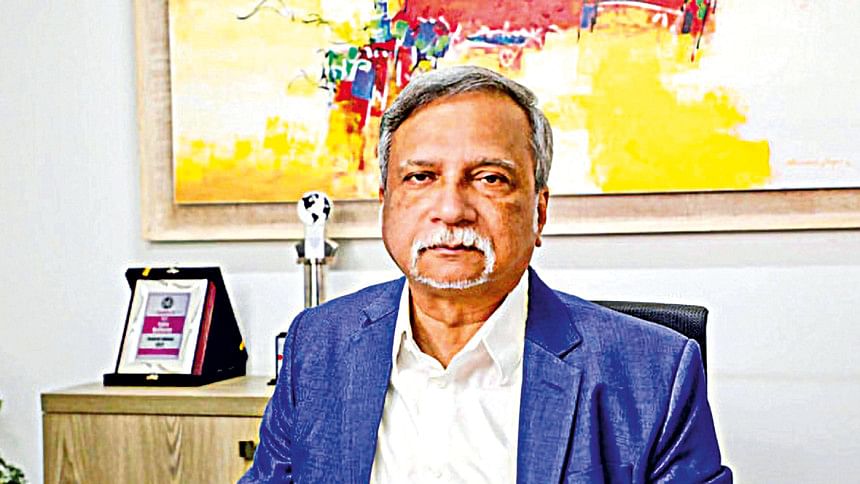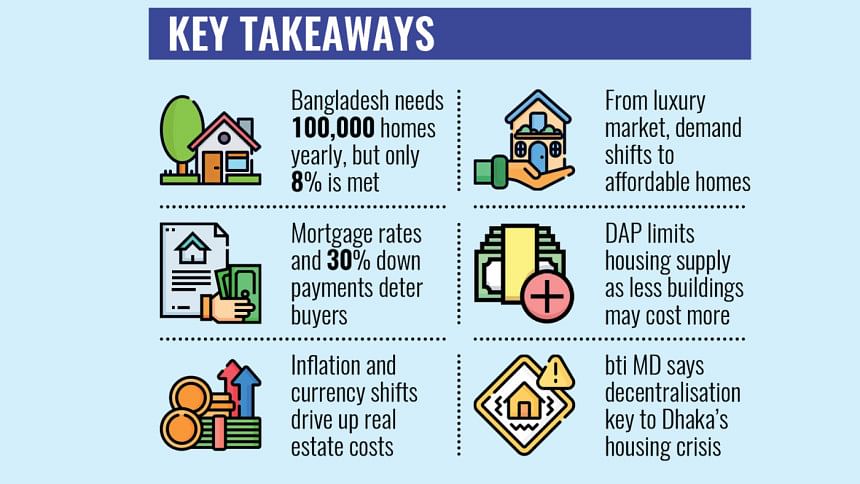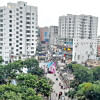Bangladesh needs one lakh flats annually

Bangladesh requires around 100,000 new apartments every year. Despite having the capacity to meet this demand, realtors can only supply 8 percent of the required units, leaving a substantial gap.
The main reason is the lack of affordability for most buyers. High mortgage interest rates further push homeownership beyond their reach.

"Frequent fluctuations in interest rates also create an added burden. Moreover, customers must manage at least 30 percent of the down payment for the total asset price, which is challenging for many," said FR Khan, managing director of Building Technology and Ideas (bti), one of leading real estate developers in Bangladesh.
A possible solution could be fixing interest rates and increasing the loan-to-value ratio offered by mortgage providers to make homeownership more accessible.
"We developers have the capacity to meet the entire demand," said Khan, who has led bti for over four decades. Founded in 1984, the company has handed over 7,500 apartments, mostly in Dhaka.
In its early years, bti expanded slowly, delivering just 10 apartments in the first decade. It later accelerated construction and now maintains an inventory of 2,000 flats, reflecting steady growth. The company has maintained timely project deliveries, even during challenging periods.
"We have completed projects despite suffering losses on many occasions. This is to honour our commitment to our clients," Khan said in an interview with The Daily Star recently.
During the interview, Khan, a graduate in civil engineering from Bangladesh University of Engineering and Technology (Buet) with a Master of Engineering in urban planning from AIT, also discussed the impact of the new Detailed Area Plan (DAP) introduced by Rajdhani Unnayan Kartripakkha (Rajuk) in August 2022, as well as the effects of the economic slowdown and political changes on the real estate sector.
"Currency fluctuations, particularly the dollar's appreciation over the last two years, have driven up raw material prices, affecting real estate costs," said the managing director of bti, which serves a broad spectrum of buyers.
It offers high-end homes priced between Tk 15 crore and Tk 20 crore, as well as apartments for those who can afford Tk 1.5 crore to Tk 2.5 crore. The company also caters to the mid-market and affordable housing segments.
Khan said that demand for luxury properties has declined due to reduced purchasing power among wealthier buyers, whereas the mid-market segment has seen an increase in demand.
"As inflation rises, many prefer investing in real estate rather than holding cash, as the real purchasing power of money is eroding," he said.
"Buyers with monthly incomes over Tk 100,000 are willing to take loans to purchase homes priced between Tk 1.5 crore and Tk 2 crore," Khan said.
However, the sector as a whole is experiencing a slowdown due to rising inflation, higher interest rates and other macroeconomic challenges.
While acknowledging that the next few years may be difficult, Khan anticipates a gradual market stabilisation as inflation eases and interest rates begin to decline.
To the seasoned realtor, who has witnessed both peaks and downturns in his career, the current economic challenges will subside within the next 18 months as the economy stabilises.
The real estate sector faced significant disruptions during the Covid-19 pandemic. However, the crisis led to an unexpected surge in property investments as individuals sought real estate as a safe asset during uncertain times.
The future appears promising, with a recovery on the horizon that could reshape the sector.
bti has continued to undertake new projects. With 72 ongoing developments, it aims to deliver 2,000 units to clients by 2025.
"Every difficult situation presents an opportunity," Khan commented.
With a background in real estate, having completed a post-master's diploma in the field in Japan, he also spoke about the contentious new DAP, which has been debated among urban planners and developers for the past two and a half years.
He said the method of calculating the Floor Area Ratio (FAR) under the new DAP, which determines building density, limits housing options in Dhaka, as the FAR has been reduced.
"Academically, the DAP is sound, but it is based on models from developed countries. Islamabad was planned in the 1960s on bare land. Everything was meticulously designed, making the city highly successful in terms of density, environment and utilities."
"But for a 400-year-old city like Dhaka, you cannot implement such changes overnight, relocate all the people and cut its density in half. Dhaka cannot afford to displace so many residents at once. Where will they go?"
Khan said that if implemented, the DAP would drive up land and apartment prices due to rising demand and limited supply.
The idea behind the DAP is that people will move to the outskirts as infrastructure expands. However, he pointed out that the FAR in these areas is even lower than in Dhaka, limiting the number of units that can be built.
"So, you cannot increase housing supply there either."
He urged the government to decentralise services and facilities so that residents of districts like Jashore and Khulna do not have to migrate to Dhaka.
"In Bangkok, authorities addressed overcrowding by decentralising infrastructure and government services, ensuring that people did not have to relocate to the capital."
"A similar approach is needed for Dhaka."


 For all latest news, follow The Daily Star's Google News channel.
For all latest news, follow The Daily Star's Google News channel. 








Comments